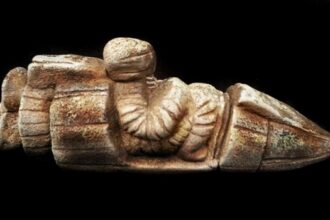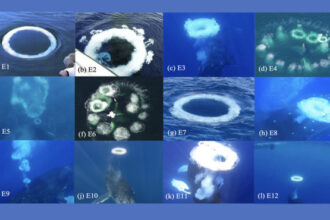For centuries, Christian pilgrims have traveled to the Italian city of Turin to venerate one of the world’s most famous religious relics.
The Shroud of Turin is a linen cloth measuring 4.35 m by 1.01 m, bearing a faint image of the front and back of a man.
Many have long believed this image was formed when Jesus was wrapped in the shroud shortly after his crucifixion about 2,000 years ago.
However, a new study claims the Shroud of Turin was never placed over Jesus’ body.
Brazilian 3D designer and historical facial reconstruction expert Cícero Moraes argues that the artifact is actually a “masterpiece of Christian art.”
Moraes used digital modeling software to compare how fabric drapes over a real human body versus a flat, low-relief sculpture.
The findings, published in the journal Archaeometry, suggest the shroud’s distinctive image could only have been produced by a sculpted form rather than direct contact with a corpse.
In his paper, Moraes concluded:
“The Shroud’s image is more consistent with an artistic low-relief representation than with the imprint of a real human body.”
To understand how the image on the Shroud of Turin might have been created, Mr. Moraes produced two digital 3D sculptures.
The first was of a full human body, while the second was a flat type of sculpture known as a low-relief.
Using various 3D simulation tools, Mr. Moraes digitally draped fabric over both models and measured where the cloth came into contact with the surfaces.
He then compared the resulting virtual fabric impressions to photographs of the Shroud of Turin taken in 1931.

The analysis revealed that the cloth placed over the low-relief sculpture matched the Shroud almost perfectly.
By contrast, the image generated by draping fabric over a real human body appeared wide and distorted.
Moraes attributes this to what he calls the “Mask of Agamemnon effect” — named after the unusually broad funerary mask discovered in a tomb at Mycenae, Greece.
When you try to project a 3D surface, such as a human face, onto a flat plane like a piece of cloth, the result becomes heavily distorted.
To illustrate how the Shroud of Turin’s image could have been made, Mr. Moraes created two digital 3D sculptures.
One model was a complete human body, while the other was a flat, low-relief sculpture.
Using advanced 3D simulation tools, Moraes digitally draped fabric over both models and measured where the cloth touched the surfaces.
He then compared the resulting virtual impressions to historical photographs of the Shroud taken in 1931.
The analysis showed that the cloth placed over the low-relief sculpture matched the Shroud almost perfectly.
In contrast, the image created by draping cloth over a real human body appeared stretched and distorted.
Moraes explains this using what he calls the “Mask of Agamemnon effect” — named after the unusually wide funerary mask found in a tomb in Mycenae, Greece.
“When you try to project a three-dimensional surface, like a human face, onto a flat surface such as a piece of cloth, the result becomes extremely distorted,” he said.
He compares it to covering your own face with paint and pressing it against a napkin: the imprint would look stretched and warped rather than like a true portrait.
Because of this, Moraes believes the Shroud’s image could not have been created by laying it over Jesus’ body.
Speaking to Live Science, he stated:
“The image on the Shroud of Turin is more consistent with a low-relief matrix.
Such a matrix could have been made of wood, stone, or metal and pigmented — or even heated — only in the areas of contact, producing the observed pattern.”
The first recorded mention of the Shroud of Turin dates back to the 14th century, and it was almost immediately accused of being a forgery.
Modern carbon dating performed in 1989 placed the Shroud’s creation between 1260 and 1390 AD. This would mean the linen used for the cloth was still growing over 1,000 years after the death of Jesus, making it impossible for it to be his authentic burial shroud.
According to Moraes’ findings, the Shroud of Turin is far more likely to be a piece of medieval Christian art rather than a sacred relic capturing the face and body of Christ.
During the medieval period, low-relief religious depictions were widely used to decorate tombs and religious sites, which aligns with the results of his study.
Some critics of Moraes’ work have pointed out that the distortions observed on the Shroud — known as the “Mask of Agamemnon effect” — had already been extensively studied in previous research, particularly by the STURP team in 1978.
That investigation argued that the distortions are not evidence of a low-relief pattern but rather an inherent characteristic of the image formation process itself.
Experts such as Ray Downing, on the other hand, emphasize that what is seen on the Shroud of Turin does not exhibit the typical features of a contact imprint, such as pigments or substances applied to the fabric.
Additionally, the image displays a diffuse quality that would not match what would be expected from direct contact with either a body or a sculpture.
The debate over the authenticity of the Shroud remains one of the most heated topics in biblical archaeology and religious history, with new research providing additional clues but still no definitive answer regarding its true origin.










